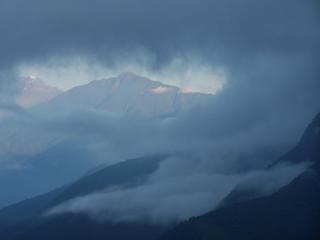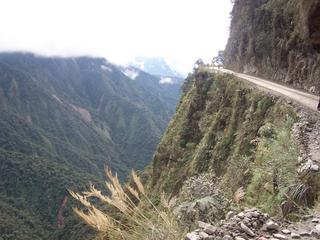Spanish School in Sucre
 It`s not a sun tan, it`s dirt. Sitting in a van post enjoying the mountain biking.
It`s not a sun tan, it`s dirt. Sitting in a van post enjoying the mountain biking. On the jungle trip, thinking about desk jobs.
On the jungle trip, thinking about desk jobs.Out of small interest re: claims to `most dangerous road`. Apparently it was named the worlds most dangerous road by the World Bank because it suffers the most deaths per person traveling on it. Because of this, the World Bank spent pots of cash building a 'new road'. But, as things go in Bolivia, the new road has a toll so everyone takes the original road anyway.
So continuing our drive along this road we were able to stop briefly to rubber neck at a car parked at the bottom of the cliff. In fact we didn´t need to rubber neck too much, we could open the door and look straight down such was our drivers liking of the edge. Buoyed then with the knowledge that people do miscellaneously drive off the edge we were able to fully relax into the rest of the journey. Particularly good were the times we caught up slowly to a vehicle ahead and through the dust white-out we could just make out the front of a large dumper truck on the single track road five feet ahead.
This was viewed most fondly by Sam who, having decided to give the brakes a rest on the mountain bike, came hurtling around a corner and was suddenly eye level with the grill of one of these trucks. Albeit they only travel at two miles an hour and stopping the bike and dismounting may otherwise have sufficed - another option was to crash to the ground as an even quicker way of stopping. (The bruises have gone now).
Just five short hours in the jeep we arrived at Guanay, our overnight stop. There were four of us on the trip and by mutual agreement our exploration of the town extended to the discovery of the first place selling beer.
On the morning of the second day (and after the nicest breakfast so far) we took the positions on the boat that we`d keep for the next three days. It was one of the long thin types not crafted by indigenous tribesmen with the handed down skills of generations. It leaked quite freely, assisted by the volume of water that found the way over the side of the boat and onto the ignorant gringos sitting in the target zone in the middle of the boat. This said the three brothers (allegedly - as they all looked totally different) who were our tour guides were very competent. In well defined pecking order the eldest was in charge of the outboard, next was the guy at the front who checked depth and gave direction hints every so often. Then there was the low order who spent the entire time bailing water.
During our holiday to date Sam has determined the activity she least enjoys is ´walking` on boulders and rocks - hence it was that our first `excursion` was to walk up a river bed for a couple of hours. When we weren`t having to balance along the precarious river route (on boulders and rocks) we were led off up the steep bank to hear some random noises (explanation in Spanish) about how wonderful some anonymous tree is at curing all that ails. The destination was nice though, a waterfall and small lake forswimming. Little did we appreciate then that every `excursion` was to be to some derivative of waterfall and small lake for swimming!
With Sam`s nerves shredded within the first half day of our relaxing boat trip we proceeded merrily on. Every time we lowered our speed Sam would look around nervously for a small river which we may be forced to march up. Unfortunately the boat dropped it`s speed every five minutes as the river had many `steps` where it became choppy and gave us all the opportunity for a soaking.
We stopped for the night at the Bolivian equivalent of Mr and MrsSmith`s place at No.1 Riverside Hut. This was a small dwelling apparently in the middle of no-where, but it was here that we saw the most jungle wildlife. We saw a deer, and a guinea pig type animal and a chicken - sadly though they were all lying prostrate on the ground, Mr Smith apparently thinking the arrival of guests warranted a little slaughtering.
That evening our overly eager guides were keen to offer us all the fruits of the forest. These were bizarre and nasty fruits which we all tentatively nibbled on with thoughts of the rural bathroom foremost in our minds. With our limited Spanish we got the gist that we should only eat the outside of the fruit and spit out the seed (for example). Unfortunately we only got this gist having munched on the seeds for a while out of a sense of having to be polite and look like we were enjoying the hospitality. Hence it was that the new game was to try to loose the fruit without being spotted, also to nod vigorously and rub our stomachs in a `mnn all this fruit is thoroughly delicious` .....`but no, despite it being so lovely we`re OK without more, thanks for the copious offerings`.
After a lovely nights sleep - interrupted only by sounds of gunfire and silhouettes of Mr Smith walking past with either of machete or shotgun - we awoke absolutely shattered to a new day. The nights accommodation was in a tent, carefully laid over Mrs Smith`s crazy-paving attempts. Speculating only briefly where our $30 a day tour costs were going we were sat down in front of some rather fresh deer and rice and anonymous substance which sucks all moisture out of your mouth on contact. It was partially because we`d just been watching the deer being butchered and cleaned in the river that made eating breakfast an ordeal - this as well as it only being 7:30am.With only a small cup of hot water as a friendly saviour we had to finish off our huge breakfasts while stoutly resisting all attempts to portion out more food.
Day two heralded a nice walk through the jungle to a pleasant waterfall with small lake for swimming. The guides rather perversely all hacked the path through the jungle with incredible zeal - ensuring our route was very pleasant if slow. Every so often however there was an `unmachetiable` obstruction, so from being cloistered so much by our guides vigorous destruction we then had to crawl under logs or large sharp dangerous looking spiky things. After a two hour stroll in humid heat we reached our lake and had a nice swim to refresh totally. Totally refreshed we then had to almost run back along our path (45mins return journey) to arrive back at the boat in a sweaty mess and looking forward to the next pleasant waterfall and small lake to swim in.
A second tour for the day saw us thinking again to that nights bathroom facilities as we were ordered, through eagerness to impress, to drink various poisonous liquids from trees or dangerous fruits from the jungle. All the trees had wonderful healing properties from preventing cancer to preventing B.O. Slightly less impressive I thought were the explanations that certain trees were good forbuilding houses with.
That evening saw us on a beach in Madidi National Park. On camp this time, no walking involved, was a waterfall with pleasant lake for swimming. That night as it became dark Sam and I were sitting on a large rock above the beach looking at the activities below (fire, cooking, tent pitching etc). It was very serene, and I think the transition for Sam into enjoying the trip (shame then that it was our last night).
The following day seemed to be a stocking filler of events. For example in the morning we traipsed through the jungle to see a burnt down house. The locals took a disliking to a gringo lady who was trying to open a tourist lodge in the jungle. When diplomacy failed they tied her up in her house and burnt it. Was our guide trying to pass us a message about a tip?
Rurrenabaque, our tours end, was a small but nice enough place. Appealing though it would be to spend 17 hours on a bus along the aforementioned dodgy road we decided we couldn`t afford the time. Hence just four days later (the earliest we could) we flew back to LaPaz. This also meant we were able to fly to the highest commercial airport in the world (blah blah blah).
Our hotel room in La Paz was intended to be a nice bit of R&R for Sam (as she was feeling a little ill) but in fact it was horrendous. We settled down for the night both sleeping on a one in five gradient -but securely moulded to the slope by seven musty blankets. We wouldn´t have felt much more uncomfortable on the mattress had we just watched it being dragged off a skip from outside.
Slightly reminiscent of old institutional buildings everywhere with high ceilings, and tall narrow dappled-glass doors we`d wake up to the sight of someone`s image walking down the squeaky wooden floored corridor. They had to walk right up to our door in order to turn right to continue down the corridor. They`d only have to stop and start clawing at our door to convince us we`d unfortunately woken up into some zombie playstation game.
So after a restful nights sleep we set off to the South, and a bus to Oruro. Apart from a big fiesta once a year there`s nothing in Oruro so the next day we were off again on the eight hour journey to Potosi. Apart from it wasn`t eight hours it was only five (as they`d paved the road since our book was written), thus followed another slightf arce....
Deciding that we may as well continue that day to Sucre (where we really wanted to be) we went straight to the ticket office. After a bit of faff we were told no more buses today. We left the ticket office and sat in a shared taxi for fifteen minutes (while they tried to find two more people). Spotting some minibuses with Sucre on the front we left the taxi and discovered there were no more seats on the mini bus. We were directed however to the front of the bus station though and hence completed the loop by getting back onto the same bus we`d just got off as it left for Sucre 45 minutes later.
We`re in Sucre now, have been for the last four days. It`s the offical capital of Bolivia and very nice, though boring after four days. We`ve been to a Sunday market about 60kms away and stocked up on Gringo tourist goodies (poncho, scarves, tops and bags). At the moment we`re in the middle of a much needed Spanish School. Soon we`ll be conversing with the locals on the current political issues of the day!!
Next week we`ll be down the famous mines at Potosi, and then on another tour over the salt flats of Southern Bolivia ... spectacular apparently with green lakes, red flamingos, volcanoes and ground and sky merging seamlessly. For now though, school is about to start for the day .... so adios.












